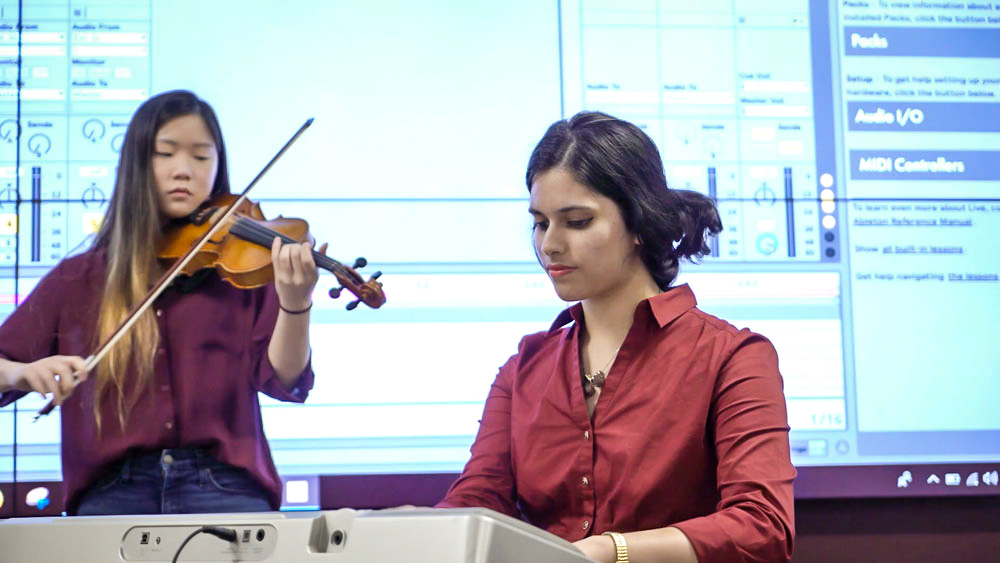Merging art and engineering into a grand musical masterpiece, students in Binomial Rhapsody are given the opportunity to explore the point at which creativity and innovation meet.
Whether they are at the opening notes of their academic symphony or transitioning into their finale, Binomial Rhapsody challenges engineering students at Texas A&M University to compose music using scientific and mathematical formulae.
“The students truly stepped up to the challenge in the way that only Aggie engineers do,” said Shayla Rivera, professor of practice and director of ENGR[x]. “The results of this program have truly exceeded any expectations I had.”
Rivera explained that the new ENGR[x] program, which includes Binomial Rhapsody, aims to spur creativity in students by offering them experiences beyond the requirements of their academic curriculum. In doing so, these programs not only give students a chance to have fun, but also develop the skills that employers desire most, including collaboration, critical and creative thinking, team building, project management, communication, leadership and self-awareness.
“When I first came to Texas A&M, I was looking to get involved with something,” said general engineering student Ritika Bhattacharjee. “From the first Binomial Rhapsody meeting, I just felt like it was where I’m supposed to be. For the first time, everything just lined up.”
Bhattacharjee, who is trained in classical piano, voice and Indian classical dance, was introduced to Binomial Rhapsody while searching for a creative outlet within the field of engineering.
“I love engineering and I love music, but sometimes I think there’s this perception that you have to choose to study either STEM or art, and there’s no way to integrate the two. But nothing is really that black and white. It’s never just a dichotomy,” said Bhattacharjee.

So, then, how is engineering like playing a piano?
Practice.
Developing the mastery of an instrument and the mastery of mathematics works in stark parallel to one another.
“The truth is that you can never master something unless you take the time to practice. The best engineers and the best artists had to spend time developing and honing their skills,” said Bhattacharjee. “Even if you’re gifted in an area, you still have to practice and develop that aptitude, otherwise it’s never going to go anywhere.”
But perhaps the most important lesson learned from practice is to accept failure.
Sometimes, experiments don’t work. Sometimes, musicians miss a note or an actor forgets a line. Innovation is creative and engineering is a constant learning curve. Things may go wrong at times, but treating failure not as a setback but as an opportunity for growth opens the doors to discovery. Likewise, practicing performing arts and embracing on-stage failure has the same effect.
“I've been to auditions that didn't go so great. I've practiced or had concerts where I've messed up and prayed that nobody in the audience knew the piece I was playing so that they wouldn't notice. But once you get used to embracing the idea of failure, I think you can do anything,” said Bhattacharjee.
Anything, including bringing together a group of engineering students from various departments to create a classical music piece inspired by Newton’s second law, which states that force is equal to mass times acceleration.
Bhattacharjee and her team calculated force by setting mass to be a constant 22 (a nod to the team’s graduation year) and varying acceleration from one through 12. The team then took their output, the aforementioned force, and converted it to a base 12 numeric system with each number corresponding to one of the 12 notes of the western classical chromatic scale. From there, they used music theory to arrange the output into music, overlaying this output with more instruments and melodies to bring the piece to life.
Through their work, Bhattacharjee and the other teams participating in Binomial Rhapsody break down the stigmatic barriers between engineering and art, inviting abstract creativity into the world of STEM.
“I would say to just ignore the dichotomy. I think we're programmed to think in a way that’s just left or right, or up or down, or black or white. But we're human, we're not computers, we're not binary code,” said Bhattacharjee. “You can be happy and you can do math and science and you can do art. So don’t listen to the dichotomy. Just be who you are.”Get Involved
Colleges and universities nationwide, together with employers and entrepreneurs, have studied and recognized a great need to broaden a student's college experience to be better prepared for their professional lives. ENGR[x] is Texas A&M University's solution.